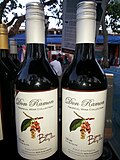Antidesma bunius: Difference between revisions
CSV import |
CSV import |
||
| Line 4: | Line 4: | ||
File:Bugnay_wine.jpg|Bugnay wine | File:Bugnay_wine.jpg|Bugnay wine | ||
</gallery> | </gallery> | ||
==Antidesma bunius== | |||
'''Antidesma bunius''', commonly known as the bignay, is a species of fruit-bearing tree in the family [[Phyllanthaceae]]. It is native to Southeast Asia and northern Australia, and is cultivated in various tropical regions for its edible fruit. | |||
==Description== | |||
''Antidesma bunius'' is a small to medium-sized tree that can grow up to 30 meters in height. The leaves are simple, alternate, and oblong to elliptic in shape, measuring 10 to 20 centimeters in length. The tree is dioecious, meaning that male and female flowers are borne on separate trees. The flowers are small, greenish-white, and arranged in axillary racemes. | |||
The fruit of ''Antidesma bunius'' is a drupe, which is initially green and turns red to black as it ripens. The fruit is about 1 centimeter in diameter and contains a single seed. The taste of the fruit is sour when unripe and sweet when fully ripe. | |||
==Distribution and Habitat== | |||
''Antidesma bunius'' is found in tropical regions of Southeast Asia, including the [[Philippines]], [[Indonesia]], [[Malaysia]], and [[Thailand]]. It also grows in northern [[Australia]] and has been introduced to other tropical areas such as [[Hawaii]] and [[Florida]]. The tree thrives in a variety of habitats, including lowland forests, riverbanks, and disturbed areas. | |||
==Uses== | |||
The fruit of ''Antidesma bunius'' is consumed fresh or processed into jams, jellies, and wines. In some cultures, the fruit is used in traditional medicine for its purported health benefits. The leaves and bark of the tree are also used in herbal remedies. | |||
In addition to its culinary uses, ''Antidesma bunius'' is sometimes planted as an ornamental tree due to its attractive foliage and fruit. | |||
==Cultivation== | |||
''Antidesma bunius'' is relatively easy to cultivate in tropical climates. It prefers well-drained soil and can tolerate a range of soil types, from sandy to clayey. The tree requires full sun to partial shade and regular watering, especially during dry periods. | |||
Propagation is typically done through seeds, although cuttings and air layering can also be used. The tree begins to bear fruit after 3 to 5 years when grown from seed. | |||
==Related pages== | |||
* [[Phyllanthaceae]] | |||
* [[Dioecious plant]] | |||
* [[Tropical fruit]] | |||
{{Taxonbar|from=Q1341465}} | |||
[[Category:Phyllanthaceae]] | |||
[[Category:Flora of Southeast Asia]] | |||
[[Category:Trees of Australia]] | |||
[[Category:Tropical fruit]] | |||
Latest revision as of 00:37, 19 February 2025
-
Antidesma bunius leaves and fruits
-
Ripe Bignay fruit
-
Bugnay wine
Antidesma bunius[edit]
Antidesma bunius, commonly known as the bignay, is a species of fruit-bearing tree in the family Phyllanthaceae. It is native to Southeast Asia and northern Australia, and is cultivated in various tropical regions for its edible fruit.
Description[edit]
Antidesma bunius is a small to medium-sized tree that can grow up to 30 meters in height. The leaves are simple, alternate, and oblong to elliptic in shape, measuring 10 to 20 centimeters in length. The tree is dioecious, meaning that male and female flowers are borne on separate trees. The flowers are small, greenish-white, and arranged in axillary racemes.
The fruit of Antidesma bunius is a drupe, which is initially green and turns red to black as it ripens. The fruit is about 1 centimeter in diameter and contains a single seed. The taste of the fruit is sour when unripe and sweet when fully ripe.
Distribution and Habitat[edit]
Antidesma bunius is found in tropical regions of Southeast Asia, including the Philippines, Indonesia, Malaysia, and Thailand. It also grows in northern Australia and has been introduced to other tropical areas such as Hawaii and Florida. The tree thrives in a variety of habitats, including lowland forests, riverbanks, and disturbed areas.
Uses[edit]
The fruit of Antidesma bunius is consumed fresh or processed into jams, jellies, and wines. In some cultures, the fruit is used in traditional medicine for its purported health benefits. The leaves and bark of the tree are also used in herbal remedies.
In addition to its culinary uses, Antidesma bunius is sometimes planted as an ornamental tree due to its attractive foliage and fruit.
Cultivation[edit]
Antidesma bunius is relatively easy to cultivate in tropical climates. It prefers well-drained soil and can tolerate a range of soil types, from sandy to clayey. The tree requires full sun to partial shade and regular watering, especially during dry periods.
Propagation is typically done through seeds, although cuttings and air layering can also be used. The tree begins to bear fruit after 3 to 5 years when grown from seed.


